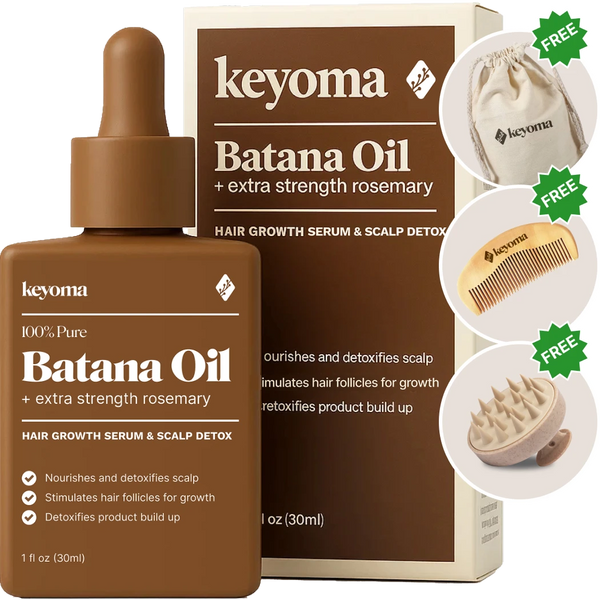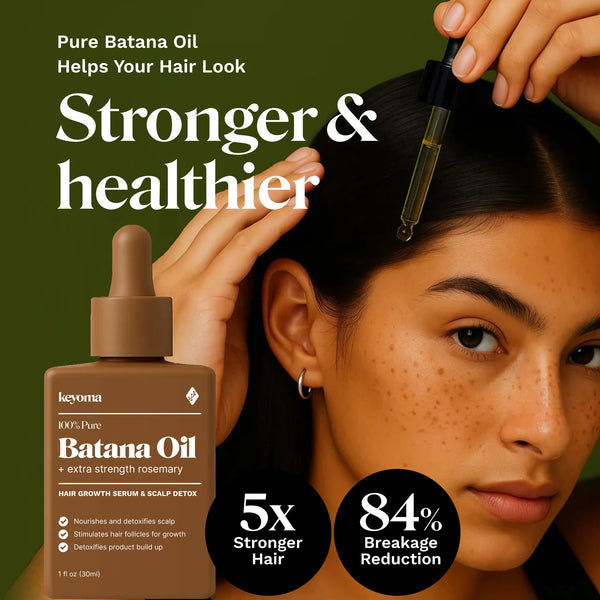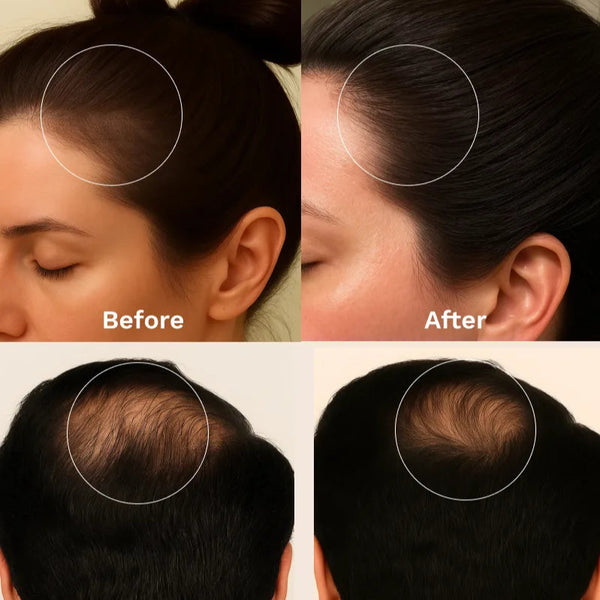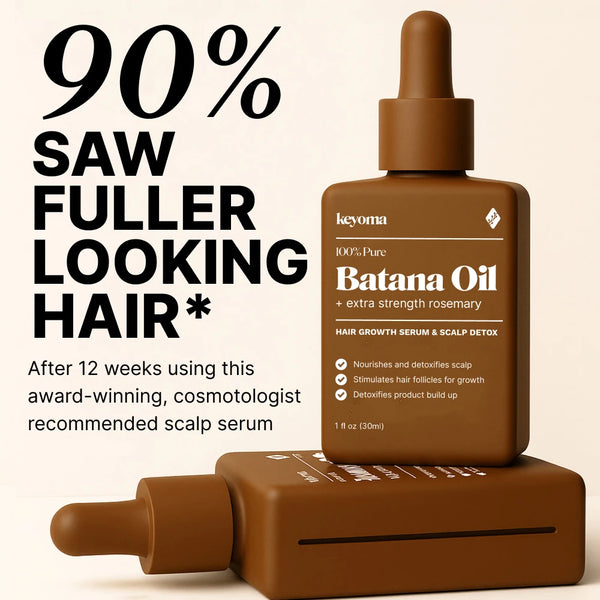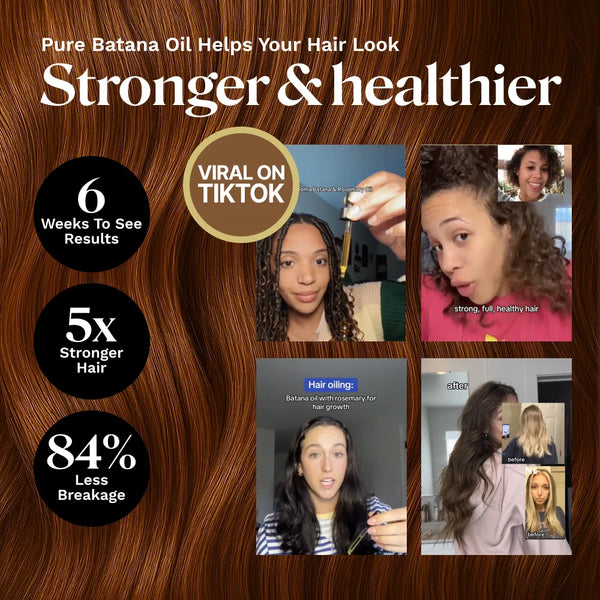In this article
By the time women reach their late 40s or early 50s, menopause often makes its presence known—not just with hot flashes or mood changes, but also when the mirror shows a widening part line or the shower drain clogs with more hair than usual.
Many will brush it off as just another part of aging, and yes, that’s true to an extent. But if you’ve ever wondered why it happens and what’s really going on inside your body, knowing the cause is the first step to knowing what you can do about it.
In this article, I’ll walk you through what science says about menopause and hair thinning, and the practical steps you can take to manage it.
Understanding the Link Between Menopause and Hair Thinning in Women
When women transition into menopause, it's not a coincidence that hair thinning becomes more noticeable. This condition is tied to deeper biological shifts happening in the body and the hair follicle itself.
Based on recent research, including a 2023 article in Frontiers in Medicine and a 2025 review in Maturitas, there are three main areas worth looking into.
Hormonal Shifts and Hair Follicle Sensitivity
According to the 2025 review Menopause and hair loss in women: Exploring the hormonal transition, the biggest trigger for menopausal hair thinning is the drop in estrogen and progesterone.
For a bit of context, hair grows in repeating cycles made up of three main stages: the anagen phase (active growth), the catagen phase (a short transition period), and the telogen phase (resting and shedding).
Both hormones influence this cycle by extending the anagen phase and keeping follicles healthier for longer. Estrogen improves blood supply and nutrient delivery to the scalp, while progesterone may slow the conversion of testosterone into DHT, the hormone known to shrink follicles.
Together, they keep hair anchored and growing steadily—until their levels decline later in menopause. And as those defenses weaken, androgens (testosterone and DHT) become more dominant, which is what often leads to female-pattern hair loss.
Metabolic and Vascular Decline in Follicles
The 2023 opinion article The Menopausal Transition: Is the Hair Follicle “Going through Menopause”? takes a different angle, focusing on the metabolic health of the follicle itself.
The researchers argue that hair follicles go through their own kind of “menopause,” meaning they lose efficiency in how they generate and use energy.
According to the article, mitochondria inside follicle cells—the tiny power plants that produce ATP (adenosine triphosphate, the cell’s main energy currency)—become less active and less abundant with age. This lowers the energy available for processes like keratin production and cell turnover.
Another key factor is the drop in estrogen, since fewer signals reach the blood vessels around the follicle to dilate. Less circulation means less oxygen and glucose, which further limits energy production.
That said, you can think of it like a factory that runs on half power. Output slows, and in this case, that means weaker, thinner strands.
Different Hair Loss Conditions During Menopause
Both studies agree that menopause isn’t tied to a single type of hair loss. Women may experience several different patterns, including:
-
Female-pattern hair loss (androgenetic alopecia): slow, progressive thinning that often starts with a widening part line and visible scalp at the crown.
-
Telogen effluvium: sudden, diffuse shedding across the scalp, often seen as clumps of hair in the shower or brush, triggered by the hormonal stress of menopause.
-
Frontal fibrosing alopecia (FFA): an inflammatory, scarring type of hair loss where the frontal hairline and eyebrows recede, increasingly recognized in postmenopausal women.
What this tells us is that hair changes during menopause are multifactorial—not just about hormones, but also about genetics, stress, diet, and even the scalp’s microbiome (the community of microorganisms living on the skin).
Menopausal Hair Thinning Treatment Options
Based on the facts we established earlier, menopausal hair thinning stems from two interconnected processes: hormonal imbalance and a decline in follicle metabolism (less energy, blood flow, and nutrient delivery).
For women, this means the solution isn’t just about “balancing hormones” or “using one product.” It’s about recognizing that menopause reshapes the entire hair growth environment, which is why a holistic approach that combines lifestyle, nutrition, and targeted hair loss treatment is often the most effective path forward.
Minoxidil
Minoxidil is the most widely studied and the only FDA-approved topical medication for female hair loss. Clinical trials show that many postmenopausal women notice improvement, though the degree of regrowth varies from person to person.
You can expect results typically within 3–6 months, but keep in mind that continued use is necessary to maintain gains. If stopped, shedding often returns.
Another thing to keep in mind is that it's generally not safe during pregnancy or breastfeeding, and not recommended if you are planning to conceive, since safety in these groups hasn’t been established.
Other Common Hair Loss Medications
These options are considered when androgens (male-type hormones that rise in relative proportion after menopause) are clearly driving hair loss. They should only be used under medical supervision since each works differently and carries its own risks and monitoring needs.
-
Spironolactone and other anti-androgens: Spironolactone blocks androgen receptors and reduces the effect of circulating testosterone and DHT on the follicle. It is often used in younger women with polycystic ovary syndrome, but can also help postmenopausal women whose bloodwork shows elevated androgens.
-
Finasteride and other alpha-reductase inhibitors: These medications work by inhibiting the enzyme that converts testosterone into DHT, the hormone strongly linked to follicle miniaturization. Evidence in women is mixed, and it is generally reserved for severe cases under strict supervision.
-
Estrogens: In topical or systemic (e.g. pills, patches, injections) form, estrogens can support scalp circulation and prolong the growth phase, though they are not used as stand‑alone hair treatments. Doctors may incorporate them in broader hormone replacement regimens when appropriate.
-
Prostaglandin analogs: Originally developed for glaucoma, these eyedrop‑derived compounds (like bimatoprost) can lengthen lashes and may stimulate scalp hair, though research is still limited.
-
Steroids: Prescribed in cases of inflammatory or scarring alopecias such as frontal fibrosing alopecia, steroids help reduce the immune‑driven attack on follicles. They are not used for typical female‑pattern thinning.
Hormone Replacement Therapy (HRT)
In practice, HRT usually involves taking estrogen (by pill, patch, or gel) sometimes combined with progesterone to protect the uterus.
These hormones circulate through the body and help ease hot flashes, improve sleep, and support bone density. As a side effect, it improves blood flow to the scalp, reduces dryness, and helps follicles stay longer in the growth phase.
That said, HRT is not prescribed solely to treat hair thinning, but rather as a part of a broader treatment plan for women struggling with severe menopausal symptoms. Doctors carefully weigh the risks (such as blood clots or breast cancer) against benefits, so it’s always a personalized decision.
Proper Nutrition
Nutrition is a cornerstone of healthy hair. That's something our moms, grandmas, and even teachers always reminded us of. Even the best medical treatments won’t work well if your body is missing essential nutrients.
During and after menopause, deficiencies in iron, vitamin D, zinc, or protein become more common. The body becomes less efficient at absorbing nutrients from food, so blood levels of key vitamins and minerals may drop even with a decent diet, directly worsening hair thinning.
What can you do? Start by eating foods naturally rich in these nutrients:
-
Lean red meat, beans, and spinach for iron
-
Salmon, eggs, and fortified dairy for vitamin D
-
Nuts, seeds, and whole grains for zinc
-
Poultry, fish, and legumes for protein
Check out our guide on the best foods for hair growth for a more comprehensive look at how diet supports your strands.
Natural Topicals
Something gentler you can use alongside prescription medications is topical care. Certain plant-based or naturally derived ingredients have shown promise in supporting circulation, calming scalp inflammation, and creating a healthier environment for follicles.
You can start with hair-nourishing oils like coconut or castor blended with essential oils, since many women have had nothing but good things to say about them. Personally, I use rosemary-infused batana oil as my daily go-to for its lightweight feel and the research that supports its effectiveness.
Regardless of what you choose, definitely pair it with a good scalp massage to help the oils penetrate more effectively.
Beyond oils, there are also shampoos for menopausal thinning. These often combine caffeine, niacinamide, or ketoconazole. Some even feature bee venom, which research suggests may stimulate follicle activity and support regrowth.
Stress Management
Elevated cortisol, the stress hormone, shortens the growth (anagen) phase and pushes more follicles into the resting (telogen) stage, which leads to diffuse shedding known as telogen effluvium.
Additionally, stress also worsens hormonal imbalance by interfering with estrogen and progesterone levels, making the menopausal transition harder on your hair.
So how to keep stress in check? Focus on these everyday habits:
-
Prioritize quality sleep: 7–9 hours helps regulate cortisol and gives your follicles time to repair.
-
Practice relaxation techniques: meditation, deep breathing, or yoga calms the nervous system and restores steadier hormone rhythms that protect your follicles.
-
Lean on support systems: talking with friends, family, or support groups eases the emotional load and helps you feel lighter.
Exercise Regularly
Exercise helps steady hormone fluctuations, improves blood flow to the scalp so follicles receive more oxygen and nutrients, and lowers cortisol levels that can otherwise trigger shedding.
Beyond hair, it also lifts mood, strengthens bones, and improves sleep, all of which create a healthier environment for growth.
The usual advice is to hit the gym a few times a week and mix in strength training, cardio, or group fitness classes. But if that’s not possible—or just not your thing—there are plenty of alternatives:
-
Brisk walking or cycling if you enjoy being outdoors.
-
Swimming or water aerobics if you need a low-impact option that’s gentle on the joints.
-
Chair yoga, stretching, or light resistance bands if you prefer gentler movement or have mobility challenges.
-
Short activity breaks at home, like dancing to music, climbing stairs, or even gardening
-
Mind-body activities like tai chi or meditation walks, which combine relaxation with light movement.
The point isn’t intensity. It’s consistency and choosing something you actually enjoy, so movement becomes part of daily life rather than a chore.
Gentle Hair Care
In the menopausal stage, where thinning and shedding are already more likely, the goal isn’t just regrowth. It’s protecting the hair you still have. Gentle care makes a real difference in how much breakage and cosmetic worsening you see day to day.
That means:
-
Skip excessive heat styling: blow dryers, straighteners, and curling irons weaken the cuticle and make thin strands look even finer.
-
Avoid harsh chemicals: strong dyes, perms, or relaxers strip away protein and moisture your hair can’t easily replace now.
-
Loosen up hairstyles: tight ponytails or braids add traction that pulls on fragile follicles.
-
Use mild, sulfate‑free shampoos: this prevents dryness and scalp irritation.
-
Condition regularly: use nourishing masks or oils to keep strands flexible and less likely to snap.
Advanced and Procedural Treatment Options
Sometimes topical treatments, nutrition, or medications aren’t enough. For women who want to explore more advanced or procedural solutions, these options are available:
-
Platelet-Rich Plasma (PRP) Injections: An emerging option that uses your own blood platelets concentrated and injected into the scalp. Results can vary, sessions are costly, and repeated treatments are usually required.
-
Low-level laser devices: Devices that use light to stimulate follicle activity and improve density. Evidence shows modest improvements, but it’s considered safe and non-invasive.
-
Hair Transplants: A last-line surgical option for women with stable patterns of loss and enough donor hair at the back or sides of the scalp. It moves follicles to thinning areas, creating permanent coverage, though it requires both investment and recovery time.
What “Excessive” Menopausal Shedding Looks Like vs. What Is Normal
Now, I know this article has focused a lot on gradual thinning, but it’s just as important to recognize that menopause can also trigger sudden, diffuse shedding.
The same hormonal shifts that thin the crown and part line can send more follicles into the shedding (telogen) phase at once. That’s why you might see clumps of hair in your brush, on the shower floor, or even on your pillow.
So what’s normal, and what’s excessive?
Normal daily shedding is about 50–100 hairs. During menopause, that number can temporarily rise, but when you’re losing more than a handful with every wash, or noticing visible scalp where you didn’t before, that suggests excessive shedding.
If this sounds familiar, don’t panic. Shedding often stabilizes, especially once hormone levels settle. And remember, the treatment options we walked through earlier are designed to slow down this process and help protect the strands you still have.
How Long Does Menopausal Shedding Last?
Excessive menopausal shedding can last anywhere from several months to a couple of years. The exact timeline is different for every woman since it depends on overall health and factors like stress levels.
Starting protective habits, such as better nutrition, medical interventions, or stress management, can also shorten what might otherwise be a longer shedding phase.
For context, shedding often begins during the perimenopause years, the stage leading up to menopause, when hormone levels first start to fluctuate. Many women notice more hair in the shower drain or on their brush at this point. Shedding typically peaks in the first year or two after the final period, then gradually slows as hormones stabilize.
Frequently Asked Questions (FAQs)
Is menopausal hair thinning permanent?
Not always. In many cases, it can be at least partly reversible with the right treatment and care. Oftentimes, hair follicles aren’t dead, but just shrunken or pushed into resting mode. By improving circulation, nutrition, and using proven treatments like Minoxidil, some density can return.
Can I use Minoxidil with clean‑beauty products?
Yes, you can. Minoxidil works at the follicle level, so pairing it with gentle, clean‑label shampoos, conditioners, or oils is fine. Just avoid layering it with heavy oils or thick serums at the same time of application, since that may block absorption. A good approach is to apply Minoxidil first, let it dry, and then continue with your clean‑beauty routine.
Is hair thinning normal during perimenopause?
Yes, it is fairly common. As estrogen and progesterone levels first begin to fluctuate, many women notice more shedding or thinner ponytails even before their final period. It can feel alarming, but it’s a normal part of the transition, and early supportive care can go a long way.
Does surgical menopause affect hair differently?
Yes. Surgical menopause, caused by removal of the ovaries, brings an abrupt and steep drop in estrogen and progesterone. Because the change is sudden (unlike natural menopause, which is gradual), hair shedding and thinning can be more noticeable in the months that follow.
Doctors may consider hormone replacement sooner in these cases, and adopting supportive hair care and nutrition habits early becomes especially important.
Protect Your Hair Throughout Menopause
Menopause changes the hair growth environment, but that doesn’t mean you’re powerless. We’ve covered how hormonal shifts, follicle metabolism, nutrition, stress, and lifestyle all shape whether your strands thin, shed, or stay strong.
The encouraging news is that with consistent care, whether that’s proven treatments like Minoxidil, supportive nutrition, or everyday steps like gentle hair care, you can protect the hair you still have and create the best conditions for regrowth.
If you ask me, a safe and easy place to start is with nourishing oils like batana oil. They give you a simple first step in your hair care routine, and when paired with other evidence‑based methods, help create a supportive foundation for healthier hair.
Featured Product
100% Pure Batana Oil + Rosemary
↓Best Batana Oil to Buy↓
1 Month
Subscribe & Save
- 30-day supply delivered monthly $35
- 30% off for life $6
- Free haircare essentials kit $33
- Free custom wooden comb $10
- Free scalp massager $15
- Free eco-friendly travel bag $8
- 30-Day Money Back Guarantee
- Free Shipping
- Online portal for easy cancel, skip, or pause.
1 Month One Time Purchase
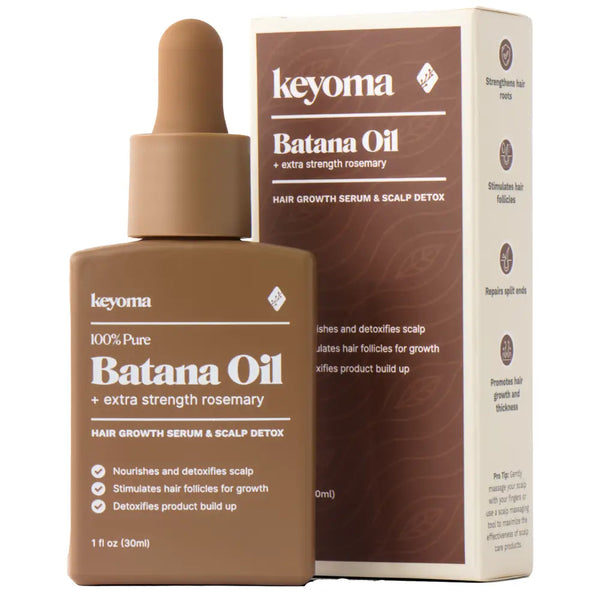
- 30-day supply $50
- 30% off for life $6
- Free haircare essentials kit $33
- Free custom wooden comb $10
- Free scalp massager $15
- Free eco-friendly travel bag $8



